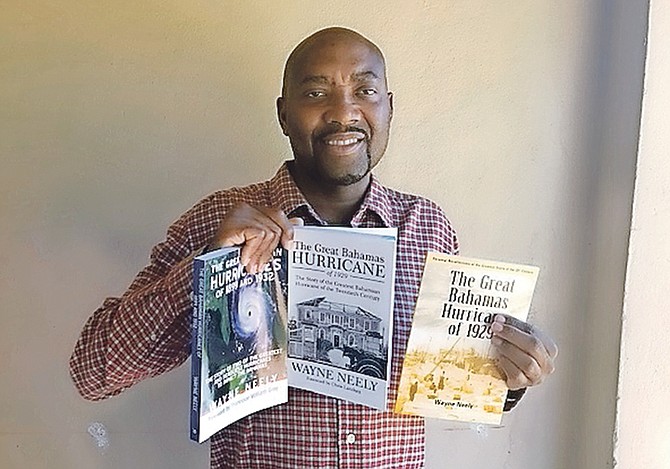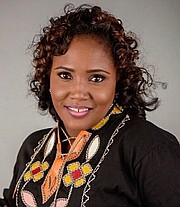By FELICITY DARVILLE
THE Bahamas has come face to face with many catastrophic hurricanes in the past, and has always proven its resilience. But there is no doubt that these powerful storms change the Bahamian landscape and impact the economy. There are lessons to be learned, and a good way to do that is to take look back in time.
Just after Hurricane Dorian had swept over us earlier this month, I spoke with veteran meteorologist Wayne Neely about the storm. He has 14 best-selling books on hurricanes, but had never witnessed anything like the destruction Hurricane Dorian left in its wake. At that time, we spoke about how Bahamians may not have taken hurricane warnings and watches seriously in the past, but that things were likely to change after the perfect storm made its presence felt.
“When I wrote these books, I wrote them with one thing in mind. I wanted these storms to be template storms - storms that we could learn from and that could help with hurricane preparedness and so on,” Wayne said.
“If we read about them, we will be able to learn from them and appreciate why they are called ‘great storms’. They are notable in the history of the Bahamas and we can learn what disasters could be like and figure out how to mitigate losses.”
After the first edition of my conversation with Wayne, many readers expressed to me that they did not know about them… like the Great Abaco Hurricane of 1932. So, I decided to expand and share more about what I learned from Wayne about the major storms that affected The Bahamas.
Great Abaco Hurricane of 1932
• Struck The Bahamas at Category 5 intensity
• Sustained winds of 160mph.
• One of only 4 Category 5 hurricanes to impact The Bahamas: 1 Great Abaco Hurricane of 1932; 2 Cuba-Brownville Hurricane of 1933; 3 Hurricane Andrew of 1992; and 4 Hurricane Dorian of 2019.
• Lowest Minimum Pressure: 930 mbar.
• Death Toll 18 persons most of them in Abaco.
• Devastated the entire Abaco mainland and Keys especially, Hope Town, Green Turtle Cay and Bluff Point (families had to relocate from Bluff Point to Murphy Town after the hurricane).
• Formed August 3- dissipated September 12, 1899.
• Damage total in The Bahamas: unknown…but estimated in the millions.
The Great Bahamas Hurricane of 1929
• Struck The Bahamas at Category 4 intensity with sustained winds of 140mph.
• Lowest Minimum Pressure: 924 mbar.
• Death Toll 142 persons most of them sponge fishermen caught at sea. Among the loss were some of the crew on the sponging vessel ‘The Repeat’.
• Devastated the NW Bahamas and stayed over Nassau and Andros for 3 consecutive days moving at 2 mph (similar to Hurricane Dorian but the 1929 Hurricane lasted a day longer).
• Formed Sept 22- Dissipated Oct 4, 1929
• Damage total in The Bahamas: unknown… but estimates placed it at over $1m.
The Great Okeechobee Hurricane of 1928
• Struck The Bahamas and Florida at Category 4 Intensity with sustained winds of 150 mph.
• Lowest Minimum Pressure: 929 mbar.
• Death Toll 4,112 total deaths, 3 in The Bahamas, ‘At least 2,500’ in the USA with approximately 1,400 of them being Bahamian migrant workers.
• Hurricane went over Lake Okeechobee and flooded the surrounding settlements with lake surge drowning most of these residents who were comprised primarily of Bahamian migrant workers working on the farms in that area.
• Devastated the West Palm Beach District.
• Formed Sept 24- dissipated October 5, 1929
• Damage total: $1.46bn. Unknown total in The Bahamas.
The Great Nassau Hurricane of 1926 and The Great Miami Hurricane of 1926
• The Great Nassau Hurricane Struck The Bahamas at Cat 4 Intensity with sustained winds of 140mph. The Great Miami Hurricane Struck The Bahamas at Cat 4 Intensity with sustained winds of 150mph.
• 77% of the annual budget in 1930 and 1931 was devoted to the rebuilding efforts of the Colony.
• Lowest Minimum Pressure: 967 mbar and 930 respectively.
• Death Toll 258-268 persons for both hurricanes but most of them were sponge fishermen caught at sea and passengers and crew of some vessels/mail boats. Among the loss were some of the crew and passengers on the mail boats ‘The Mountain King’ and ‘The Brontes’. Both of these crew and passengers were lost at sea during the hurricane with one notable exception. Napoleon Rolle was the lone survivor. Napoleon had convinced the captain of the Mountain King to try and outrun the storm and make his way through the Exuma Cays. The storm still caught them and ironically, only Napoleon was ever found.
• This 1926 season of 2 Category 4 Hurricanes and 1 Category 1 hurricane was the impetus for the introduction of ZNS (Broadcasting Corp. of The Bahamas) - as a Hurricane Warning Station.
• Devastated the entire Bahamas but the greatest devastation occurred in Nassau hence the name ‘The Great Nassau Hurricane of 1926’ formed July 22 and dissipated August 2, 1926. ‘The Great Miami Hurricane of 1926’ formed September 11 and dissipated: September 22.
• Damage total in The Bahamas in the Nassau Hurricane: more than $5m and in the Great Miami Hurricane: more than $2m.
Great Bahamas Hurricane of 1899 (also called The Great San Ciriaco Hurricane):
• Struck The Bahamas at Category 4 intensity
• Sustained winds of 150mph.
• Lowest Minimum Pressure: 930 mbar.
• Death Toll 334 persons most of them sponge fishermen caught at sea near Exuma and in the vicinity of The Mud in Andros.
• Devastated the entire Bahamas.
• Formed August 3- dissipated September 12, 1899
• Damage total in The Bahamas: Unknown…But estimated in the millions.
The Great Bahamas Hurricane of 1866
• In October 1866, a powerful Category 4 hurricane struck the Bahama Islands.
• Winds well over 140 miles per hour and even higher gusts that toppled trees, sank ships, peeled away rooftops, and destroyed vital infrastructures, the massive storm battered the islands with great ferocity.
• When the seas finally calmed and the winds died down, the massive storm had killed more than 387 people in the Bahamas alone and left a massive trail of destruction.
The Great Hurricane of 1780-The story of the Greatest and Deadliest Hurricane of the Caribbean and the Americas:
• The Great Hurricane of 1780, also known as Hurricane San Calixto II, is one of the most powerful and deadliest North Atlantic hurricanes on record. Often regarded as a cataclysmic hurricane, the storm’s worst effects were experienced on October 10, 1780.
• This storm likely generated in the mid-Atlantic, not far from the equator. It was first felt in Barbados, where just about every tree and house on the island was blown down. The storm passed through the Lesser Antilles and a small portion of the Greater Antilles in the Caribbean between October 10 and October 16 of 1780.
• Because the storm hit several of the most populous islands in the Caribbean, the death toll was very high. The official death toll was approximately 22,000 people but some historians have put the death toll as high as 27,500. Specifics on the hurricane’s track and strength are unclear since the official North Atlantic hurricane database only goes back as far as 1851. Even so, it is a fact that this hurricane had a tremendous impact on economies in the Caribbean and parts of North America, and perhaps also played a major role in the outcome of the American Revolution. This thoroughly researched history considers the intense storm and its aftermath, offering an exploration of an important historical weather event that has been neglected in previous study.
Wayne covers other major storms in books such as “The Major Hurricanes to Affect The Bahamas” which includes all of the major hurricanes to impact The Bahamas from 1500 to 2005, including: Hurricanes Frances, Jeanne-2004; Wilma-2005; Michelle-2001; Andrew-1992; Floyd-1999; David-1979; Betsy in 1965; Donna-1960; and 1933 hurricane season, which had 21 named storms, including four hurricanes and one tropical storm impacting The Bahamas during this season… with one being a Category 5 hurricane.
He also authored “Rediscovering Hurricanes”. This book includes all of the major Hurricanes of The North Atlantic from 1494 to present including: Hurricanes Andrew, Mitch, Katrina, Camille, David, Betsy, the Great Hurricane of 1780, Hurricane Gilbert, the Hurricane of 1495 and countless others.
Over the years, Wayne has written or contributed to numerous articles on hurricanes and other severe weather events for some of the major local and international newspapers and magazines, including: National Geographic, Weather-Wise Magazine, Weather Brains, Hurricane-City, The New York Times, Time, Newsweek, People, Huffingpost, The Washington Post, and the American Meteorological Society. He speaks at schools, colleges and universities around the world and at home. He is featured on radio and television interviews both locally and abroad about the history and impact of Bahamian, American and Caribbean hurricanes and hurricanes in general. He has been a hurricane advisor for both “Jeopardy” and “Who Wants to be a Millionaire” on several occasions. He contributed to and was featured in the very popular PBS/NOVA Documentary called “Killer Hurricanes”.
“Hurricanes are monsters of nature and they have a single overriding purpose,” Wayne said.
“Once we understand their purpose, we can understand them in general.”
Hurricanes actually have benefits, he explains. They act as the earth’s filter system by removing toxic and polluted air out of The environment. If there were no hurricanes, the air would eventually get extremely more toxic and not support life on this planet. They act as a temperature balance by removing heat from the equator and transferring it to the poles.
The cold front on the other hand, transfers cold air from the poles to the equator. That’s their primary mandate and if the temperature balance didn’t take place, the Equator would get progressively hotter and hotter and the polar regions would get progressively colder and colder and not support life.
Ocean currents and upper level winds also have similar functions. Hurricanes and hurricane related systems like tropical storms and easterly or tropical waves accounts for 60% of the rainfall in the tropics and if there were no hurricanes, it would spell disaster for industries like agriculture, chemicals, bottled water, manufacturers and other industries dependent on water resources. They replenish plant life by removing weak or dying trees and plant life. Hurricanes also replenish barrier islands.
Find Wayne’s books on hurricanes on Amazon as well as in local bookstores. Email him at: wayneneely@hotmail.com.






Comments
bahamianson 4 years, 7 months ago
So much for climate change
Groidal 4 years, 7 months ago
except now we get these every year
sheeprunner12 4 years, 6 months ago
What happened to Joaquin in 2016????? ............ Soooooo, if it doesn't hit Nassau or NW Bahamas, it is not considered a major hurricane???????
If the country had paid attention to Joaquin, we won't have been in this situation with Dorian. Every problem that Dorian presented was exposed in Joaquin ........ sea surge, storm stalling, Cat5 ground impact, infrastructure failings, slow official response & recovery, official corruption, NGO partnerships, and unchanged mitigation strategies
Sign in to comment
Or login with:
OpenID